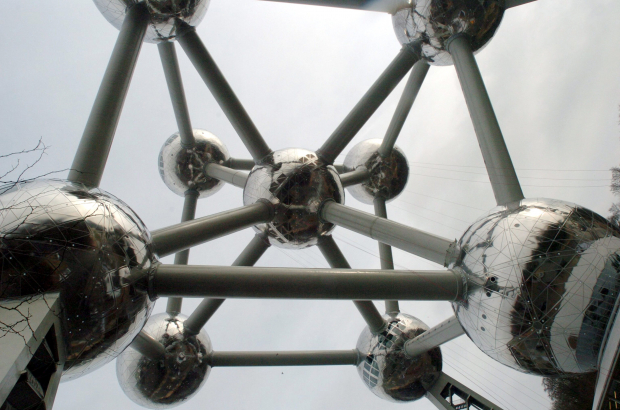- Daily & Weekly newsletters
- Buy & download The Bulletin
- Comment on our articles
Was the Atomium built without planning permission?
Has the Atomium been an illegal construction for more than 60 years? Despite being Belgium’s most recognisable symbol since it was built in 1958, the Atomium apparently doesn’t exist in any official administrative documents related to the necessary permits.
How can this 102-metre structure, the centrepiece of the World Fair and the Heysel Plateau, be so present in selfies, in paintings, on postcards, in collective memory and yet be so absent in the regulatory files of the buildings department?
In the Archives of the City of Brussels, the memory banks of the capital, there are documents dating from the Middle Ages to the present day, whatever the medium (parchment, paper, photographs, electronic data...). There are press clippings, plans, posters, drawings, models, and applications for planning permission.
There are no less than 280 files concerning the Atomium, but none relate to a building permit dating back to before 1958, the year of its inauguration. There is no trace of any request for regularisation, the process of legalising a building once it has been built. In this case, the authorities then decide if the building is awarded a permit or not. In the case that the permit is refused, the building must be torn down.
The owners of the Atomium, the ASBL Atomium, could have applied for regularisation before the major renovation of the monument undertaken between 2004 and 2006. At the time, the public authorities (Federal State, Brussels-Capital Region and City of Brussels) had raised more than €25 million to restore one of the last vestiges of Expo 58.
Back at its inauguration, the Atomium was given a six-month lifespan. It was meant to stand proudly as the focal point of the World Fair and then be dismantled after the event was closed. It was nigh on impossible back in 1958 to imagine the affection the building would stir in the hearts of the country’s populace. But stir them it did, and its unthinkable destruction was postponed. And postponed again, year after year.
Those investigating the curious case of the missing planning permission wonder if the Atomium’s original intended lifespan has something to do with the lack of paperwork. No one expected it to stay standing for over six months, let alone over 60 years.
Michael Amara, a historian at the State Archives, which ensures the preservation of documents relating to Expo 58, said that agreements between the City of Brussels and the Office of the Expo made the land the Atomium stands on available as early as 1957. He says it was up to the Office of the Commissioner to distribute the plots, to develop the roads and to build more than 600 buildings on the site for Expo 58.
"It is impossible to be 100% sure without having carried out an investigation to determine the exact content of these conventions and what they set for the pavilions and buildings to be built there," he said. "These were designed as temporary and intended to be dismantled as early as the end of 1958. For understandable reasons, it could be that permits were not required for these hundreds of temporary buildings. It would be quite logical. One hypothesis would be that the urban situation of the few preserved buildings, including the Atomium, was never regularised thereafter."
Brussels municipal councillor Geoffroy Coomans de Brachene agrees that this oversight may have occurred. "I fully understand that this could have been possible in 1957-1958, especially for a building that had a lifespan of only a few months or even a few years at most."
However, he added, "during the 2006 restoration, the authorities must have noticed this oversight. Unless it is manifest incompetence. And at that time, it would certainly have been necessary to regularise the building. No one would have challenged it. After a few jokes, everyone would have forgotten about it."
“If this is correct, and the Atomium has no permit and hasn’t been regularised, then one could really say that Belgian surrealism - and Brussels - has a bright future ahead of it," concluded Coomans de Brachene, somewhat ironically.
The lack of paperwork also goes some way to explain why the Atomium didn’t have an official address until 2018 since, on paper at least, it didn't officially exist. Almost three years ago, on 9 July 2018, the Brussels authorities put this right when it finally awarded the Atomium its own official street plaque and address: Place de l'Atomium 1 - Atomiumplein 1.
Maybe it doesn’t matter that there is no paperwork. Maybe over time a temporary building that has become permanent doesn’t need one.
But what exactly does the City of Brussels, the partner of the Atomium, think about this mystery? Ans Persoons, the Brussels councillor responsible for urbanism confirms the political consensus. "There will obviously be no problem on our side to regularise the Atomium if the question arises," read a statement from her office. "For us, the question does not arise: there is no reason to apply for a permit now."
There is no reason because there is no challenge. No one would think today of dismantling the Atomium or questioning its creation. And so, at least for now, the 63-year-old temporary structure will remain where it is – on Place de l'Atomium 1 - Atomiumplein 1 and in the hearts of millions.

















